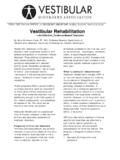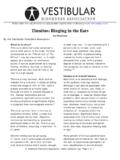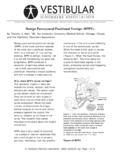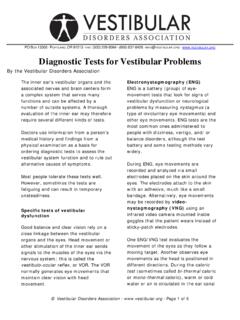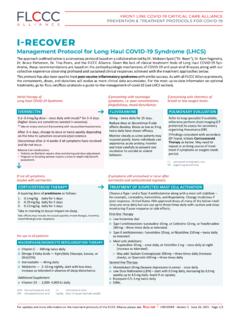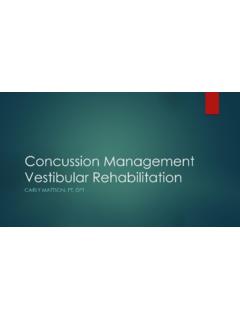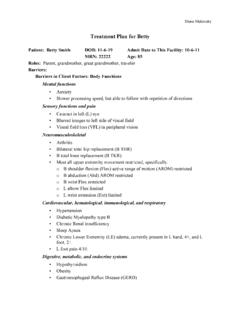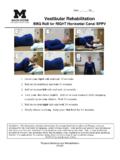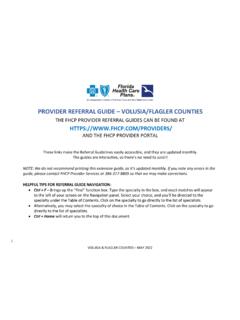Transcription of Persistent Postural- DISORDERS Perceptual Dizziness
1 :: 049 / DISORDERS1 HISTORYIn 1986, German neurologists Thomas Brandt and Marianne Dieterich first described a condition that they called phobic postural vertigo (PPV). Symptoms included postural Dizziness without vertigo and fluctuating unsteadiness provoked by environmental or social stimuli ( crowds), which could not be explained by some other neuro-otologic disorder. Triggers included a pre-existing vestibular disorder, medical illness or psychological criteria of PPV included the presence of an obsessive-compulsive personality, mild depression, and anxiety. Studies on PPV showed that it was NOT a psychiatric disorder, but rather a neuro-otologic condition with behavioral the early 2000s, the American team of Jeffrey Staab, Michael Ruckenstein, & their colleagues performed studies to update the concept of PPV and described the clinical syndrome of chronic subjective Dizziness (CSD).
2 The symptoms of CSD included non-vertiginous Dizziness and unsteadiness that was increased by a person s own motion, exposure to environments with a complex or moving stimuli ( , stores, crowds), and performance of tasks that required precise visual focus ( , reading, using a computer). Other vestibular experts described space-motion discomfort and visual vertigo, symptoms that overlapped to some extent with PPV and 2010, scientists from around the world began a process of identifying the most important features of these syndromes. In early 2014, they reached a consensus on the key symptoms and defined a diagnosis of Persistent Postural- Perceptual Dizziness (PPPD).
3 DISORDERS5018 NE 15th Ave. Portland, OR 97211 1-800-837-8428 PsychiatricPPPD typically starts shortly after an event that causes acute vertigo, unsteadiness, Dizziness ,or disruption of THIS ARTICLE HELP YOU?SUPPORT VEDA @ Postural- Perceptual DizzinessBased on an article written by Dr. Jeffrey P. :: 049 / DISORDERS2 The World Health Organization has included PPPD in its draft list of diagnoses to be added the next edition of the International Classification of Diseases (ICD-11) in The primary symptoms of PPPD are Persistent sensations of rocking or swaying unsteadiness and/or Dizziness without vertigo lasting 3 months or more; Symptoms are present on more days than not (at least 15 of every 30 days); most patients have daily symptoms.
4 Symptoms are typically worse with: Upright posture (standing or sitting upright) Head or body motion Exposure to complex or motion-rich environments PPPD typically starts shortly after an event that causes acute vertigo, unsteadiness, Dizziness , or disruption of balance such as: A peripheral or central vestibular disorder ( , BPPV, vestibular neuritis, Meniere s disease, stroke) vestibular migraine Panic attacks with Dizziness Mild traumatic brain injury (concussion or whiplash) Dysautonomia (disease of the autonomic nervous system)Other medical problems, such as dysrhythmias and adverse drug reactions that manifest with acute bouts of vertigo, unsteadiness or Dizziness are less common triggers of rarely starts slowly and gradually without a triggering event, although it is not always possible to sort out the or mild depression may be present as comorbidities.
5 However, they are not symptoms of PPPD, as they were with may coexist with other vestibular DISORDERS , which can confuse the diagnosis since patients may exhibit other symptoms, including with PPPD may have a history of vertigo, suggesting a previous vestibular dysfunction. Patients typically exhibit chronic symptoms due to accumulated exposure to motion stimuli, making them more susceptible to recurrence of with PPPD avoid situations that may exacerbate symptoms because they don t want to feel worse physically. Some patients also avoid these situations because they are afraid that something terrible might happen.
6 Thus PPPD is a physiological disorder that can have psychological exams, laboratory tests, and neuroimaging are NOT used to diagnose PPPD itself, but to identify potentially comorbid conditions, which can lead to a suspected diagnosis of examination and laboratory testing are often normal or may show a current or previous vestibular problem that does not fully explain the patient s to look for: Primary symptoms (unsteadiness &/or Dizziness , present 3 months or more); fluctuate in severity depending on triggers; Primary symptoms are related to body posture symptoms are most severe when walking or standing, less severe when sitting, and minor or absent when lying that provoke or exacerbate symptoms: Active or passive motion of self not related to specific direction or position; THE PRIMARY SYMPTOMS OF PPPD ARE Persistent SENSATIONS OF ROCKING OR SWAYING UNSTEADINESS AND/OR Dizziness WITHOUT VERTIGO LASTING 3 MONTHS OR :: 049 / DISORDERS3 Exposure to moving visual stimuli or complex visual patterns; performance of precision visual tasks ( reading, computer).
7 Triggering events: Acute or recurrent peripheral (more common) or central (less common) vestibular disorder; Medical problems or psychiatric DISORDERS that produce unsteadiness or FACTORSB ehavioral assessment of PPPD patients may be normal and/or show low levels of anxiety and depression. Other psychiatric DISORDERS may also factors contribute to PPPD in three ways: Individuals with anxious, introverted temperaments or a pre-existing anxiety disorder may be predisposed to PPPD after a precipitating event; Individuals who exhibit a high level of anxiety while they are experiencing vestibular symptoms may be more likely to develop PPPD; A primary predictor of PPPD is when a patient who first experiences an acute vestibular episode displays high levels of anxiety and caution, coupled with expectations for a negative outcome.
8 This heightened anxiety is like a self-fulfilling prophesy, in that the result is generally a poor rate of anxiety intensifies postural instability and reactivity to motion stimuli during acute vestibular trauma and slows recovery by preventing the patient from developing adaptive and depression can increase the likelihood of developing PPPD. 60% of patients with PPPD had clinically significant anxiety; 45% of patients had clinically significant depression; 25% of patients had 2014, no large scale, randomized, controlled trials of therapeutic interventions for CSD had been conducted, but several smaller studies have been completed around the clinical trials for the use of SSRIs (selective serotonin reuptake inhibitors) and SNRIs (serotonin norepinephrine reuptake inhibitors) on patients with CSD: Primary symptoms were reduced by at least half in 60%-70% of patients to entered the trials and 80% of patients who completed at least 8-12 weeks of treatment.
9 Dropout rates due to medication intolerance averaged 20% (adverse effects included nausea, sleep disturbance, and sexual dysfunction).Patients who do not respond to one SSRI have a good chance of responding to another one. Increased Dizziness was rarely observed, and comorbid anxiety and depression were improved. Treatment must be maintained for at least one year or more to minimize and other vestibular suppressants are NOT effective as a primary treatment for Balance rehabilitation therapy (VBRT) vestibular /balance rehabilitation therapy works to desensitize or habituate patients to motion 2014, the first small study on the efficacy of VBRT specifically for PPPD patients was completed.
10 Its results support previous clinical experience and suggest the following: VBRT reduces the severity of vestibular symptoms by 60%-80%, resulting in increased mobility and enhanced daily functioning; :: 049 / DISORDERS4 VBRT may be effective in reducing anxiety and depression in PPPD patients; Patients should continue VBRT for 3-6 months to receive maximum benefit from the is not a very successful treatment for fully established, longstanding PPPD, but it may be able to reduce the chances of developing PPPD if used early. Older trials showed that cognitive behavioral therapy (CBT) had a moderate effect for reducing Dizziness in patients with PPPD, but, unfortunately the benefits did not last after therapy was finished.

